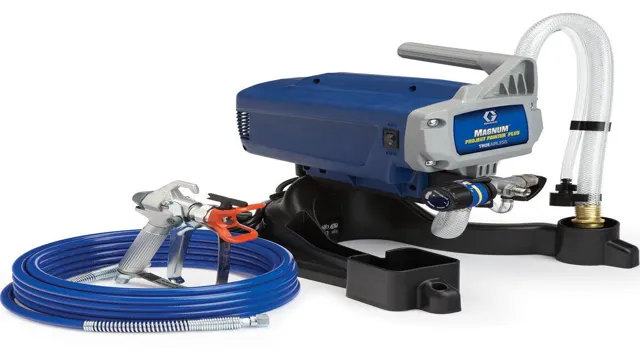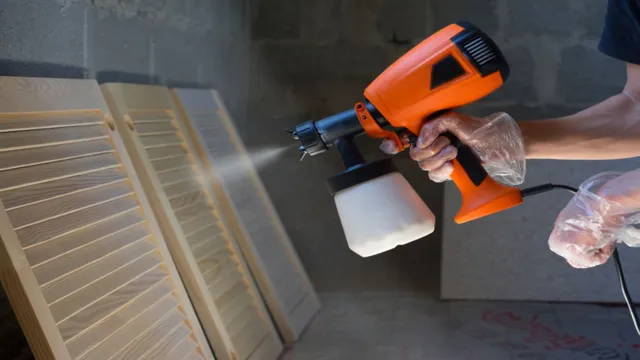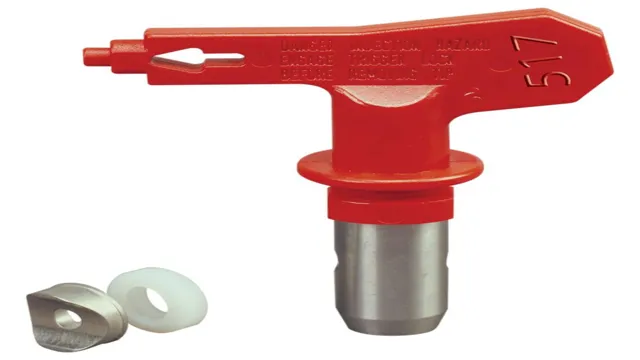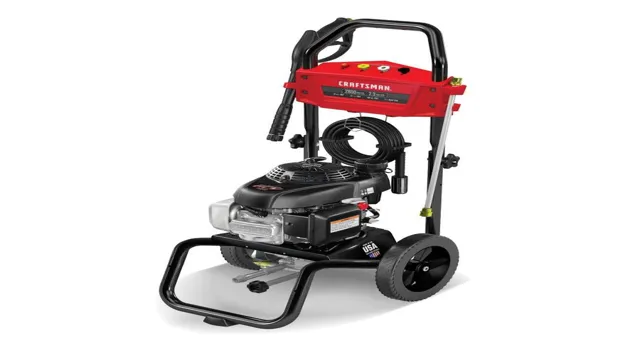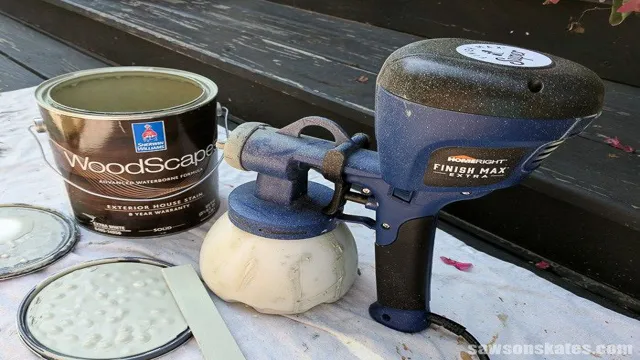Can You Use a Paint Sprayer with Masonry Paint? Pros and Cons Explained
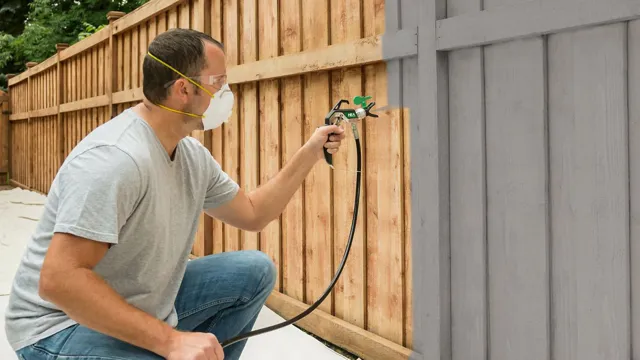
Are you tired of painting the exterior walls of your house with a brush or roller? It can be a tedious and time-consuming process, especially if you’re dealing with textured surfaces like masonry. Well, why not try using a paint sprayer with masonry paint? Using a paint sprayer can make your painting job much faster and efficient, giving you more time to enjoy the things you love. Plus, it can provide a smoother finish and better coverage compared to using a brush or roller.
Using a paint sprayer with masonry paint can be a game-changer, but it’s important to understand how to use it properly. In this blog, we’ll provide you with some tips and tricks to help you achieve a professional-looking finish on your exterior walls. So, grab your paint sprayer and let’s get started!
Understanding Masonry Paint
If you have been considering painting the exterior walls of your home or business premises, you might be wondering whether you can use a paint sprayer with masonry paint. The answer is yes, but you need to choose the right type of sprayer and ensure that you follow the instructions carefully. Masonry paint is typically thicker than other types of paint, and it requires a sprayer that can handle thicker coatings.
Make sure the sprayer you choose has a large enough nozzle size that can handle the thicker consistency of masonry paint without clogging or breaking the sprayer. It’s also important to remember that masonry paint is designed to penetrate and seal porous surfaces, so you need to apply it in thin, even coats to achieve the desired results. Overall, a paint sprayer can be an efficient and effective way to apply masonry paint, but you need to do your research, choose the right equipment, and follow the manufacturer’s guidelines to ensure a successful outcome.
Composition
Masonry paint is a type of paint designed for use on bricks, stones, and other masonry surfaces. It is made up of pigments, resins, and additives that are specially formulated to provide a durable, weather-resistant finish that can withstand the harsh elements over time. The composition of masonry paint allows it to penetrate deeply into the pores of the surface, creating a strong bond that resists peeling, cracking, and flaking.
One of the benefits of masonry paint is that it comes in a variety of colors, allowing you to customize the look of your masonry surface to suit your taste. It is also easy to apply, typically requiring only one coat for satisfactory coverage. Depending on the surface, masonry paint can be applied with a brush, roller, or spray gun.
Overall, masonry paint is a great way to protect and beautify your masonry surfaces for years to come.
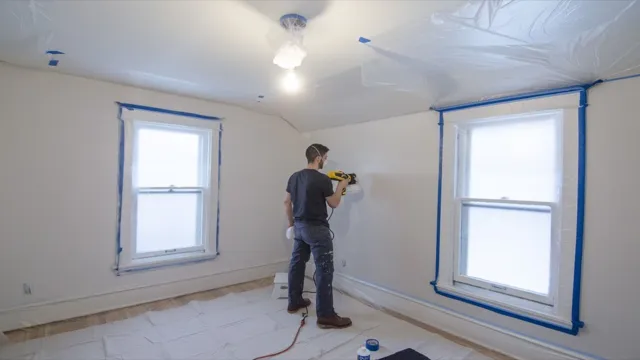
Properties and Benefits
If you are looking for a way to protect and enhance the look of your masonry surfaces, then you may want to consider using masonry paint. Masonry paint is specifically designed to provide long-lasting protection against weathering elements, such as moisture and sunlight. Additionally, it can be used to cover up unsightly stains and blemishes on masonry surfaces.
One of the benefits of using masonry paint is that it allows the surface to breathe, which means that it won’t trap moisture and lead to mold and mildew growth. Moreover, it offers a wide array of colors and finishes, from matte to gloss, giving homeowners and property managers the flexibility to choose the most suitable paint for their needs. With masonry paint, you will not only enhance the look of your property but also provide it with lasting protection.
So why not try masonry paint today and see the difference it can make?
Benefits of Using a Paint Sprayer
Yes, you can use a paint sprayer with masonry paint, and it actually has several benefits compared to using traditional methods. First of all, a paint sprayer provides a much faster and more efficient application process, helping you to complete your painting project in less time. Additionally, a paint sprayer allows for a more even and uniform coverage, which is especially important when working with certain types of paint like masonry paint, which tends to be thicker and heavier.
Using a sprayer can also enable you to reach difficult-to-reach areas more easily, resulting in a more comprehensive and professional-looking finish. Furthermore, cleaning up after using a paint sprayer is generally quicker and easier than cleaning traditional painting tools. All in all, using a paint sprayer with masonry paint can save you time and effort, while also providing a high-quality and aesthetically pleasing result.
Efficiency and Speed
When it comes to painting a large surface area, using a paint sprayer can be a game-changer for both efficiency and speed. With a traditional brush or roller, it can take hours to apply a coat of paint, and even longer to give it a polished finish. With a paint sprayer, however, you can cover large surfaces in a fraction of the time it would normally take.
Not only does it save time, but it can also help you achieve a more even finish without leaving behind any brush or roller marks. Plus, since paint sprayers can deliver a precise and consistent spray pattern, you can avoid any unwanted drips or smears that can occur with more traditional painting methods. In short, using a paint sprayer can be a great way to save time, improve the quality of your painting, and make the painting process a lot more efficient.
So, why not give it a try?
Uniform Coverage
When it comes to painting, achieving a uniform coverage can often be a difficult task. Thankfully, using a paint sprayer can simplify and expedite the process while also providing a range of benefits. First and foremost, paint sprayers produce a consistent and even finish, eliminating brush or roller marks and ensuring every surface is covered evenly.
Additionally, using a sprayer can save time and energy as it allows larger areas to be covered in a shorter amount of time compared to traditional painting methods. Paint sprayers can also be more economical as they waste less paint than brushes or rollers which is better for the environment and your wallet. So if you want to save time, improve efficiency, and achieve a quality finish, a paint sprayer is definitely worth considering.
Using a Paint Sprayer with Masonry Paint
Yes, you can absolutely use a paint sprayer with masonry paint. In fact, using a sprayer can make the job of painting your exterior brick or concrete surfaces much easier and quicker. However, it is important to note that not all paint sprayers are designed to handle the thicker consistency of masonry paint.
You will need to ensure that you have a sprayer that is specifically designed for this type of paint. Additionally, it is important to properly prepare the surface before using the sprayer. This includes thoroughly cleaning the surface and repairing any cracks or holes.
When using the sprayer, be sure to keep a consistent distance from the surface and use smooth, even strokes. With the right equipment and technique, using a paint sprayer with masonry paint can provide a beautiful and long-lasting finish to your exterior surfaces.
Preparation
Preparation is key when using a paint sprayer with masonry paint. Before you start, ensure that the surface is clean and free of debris, mold, and mildew. A pressure washer can help to remove any dirt from the surface, and a wire brush can help to remove any loose paint or debris.
Once the surface is clean, it’s important to mask off any areas that you don’t want to paint, such as windows and doors. Cover any nearby plants and outdoor furniture with plastic sheeting to protect them from overspray. Additionally, it’s important to wear protective clothing, including gloves and a mask, to avoid any chemical exposure while using the sprayer.
By properly preparing the surface and protecting the surrounding area, you can ensure that your masonry paint will be applied smoothly and evenly with a paint sprayer.
Equipment
Using a paint sprayer with masonry paint can provide a quick and efficient way to give your home’s exterior a new look. However, it’s important to use the proper equipment to ensure the job is done correctly. To start, you’ll need a high-quality paint sprayer designed for masonry paint and a compressor to power it.
You’ll also need a mask to protect your lungs, safety goggles to protect your eyes, and gloves to prevent skin irritation. Before you begin, make sure to clean the surface thoroughly and remove any loose material. When applying the paint with the sprayer, it’s important to maintain an even distance from the surface to prevent drips or runs.
With the right equipment and technique, using a paint sprayer with masonry paint can save time and provide a professional-looking finish.
Tips for Using a Paint Sprayer with Masonry Paint
Yes, you can use a paint sprayer with masonry paint, but there are a few things you should keep in mind to achieve professional results. First of all, make sure to choose a paint sprayer that is suitable for masonry paint. Most sprayers on the market are designed to work with latex or oil-based paints, so look for one that has a larger nozzle and higher horsepower to handle the thicker consistency of masonry paint.
Additionally, make sure to properly prepare the surface before painting, which typically involves pressure washing and patching any cracks or holes. When it comes to applying the paint, start with a small test area to get familiar with the sprayer and adjust the settings as needed. It’s also important to maintain a consistent distance from the surface and avoid overlapping too much to prevent drips and uneven coverage.
Overall, with the right tools and technique, using a paint sprayer can make painting with masonry paint faster and easier while achieving a professional-looking finish.
Conclusion
In conclusion, the question of whether you can use a paint sprayer with masonry paint boils down to this: it’s not rocket science, but it’s not finger-painting either. With the right equipment and technique, a sprayer can produce a smooth, even coat on your bricks or concrete, but it may require a bit more preparation and cleanup than brushing or rolling. So if you’re up for the challenge and want to cut down on your painting time, go ahead and give it a shot – just don’t forget to wear a face mask and cover your plants, unless you want a be-speckled foliage effect.
“
FAQs
What type of sprayer should I use for masonry paint?
You should use an airless paint sprayer specifically designed for masonry paint.
Can you use a regular paint sprayer for masonry paint?
No, you should not use a regular paint sprayer for masonry paint. Masonry paint is thicker and requires a sprayer specifically designed for it.
How do you thin masonry paint for a sprayer?
You should follow the manufacturer’s instructions on thinning masonry paint. Typically, it will require a small amount of water or a specific thinning agent.
Is it better to spray or brush masonry paint?
While it is possible to brush on masonry paint, spraying will provide a more even finish and allow you to cover large areas quickly.
Can you use a HVLP sprayer for masonry paint?
No, you should not use a HVLP sprayer for masonry paint. HVLP sprayers are designed for thinner materials and would not be effective for masonry paint.
What is the best technique for spraying masonry paint?
Spray in a back and forth motion, keeping the sprayer at a consistent distance from the surface and overlapping each pass slightly.
Can you use a paint sprayer for textured masonry surfaces?
Yes, you can use a paint sprayer for textured masonry surfaces. However, you may need to use a thicker tip and adjust the pressure to account for the texture.

